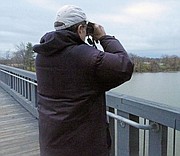William Young took this picture of the American Redstart in the brush at LBJ Grove a few days after the Christmas Bird Count on Dec. 19. Photo by Shirley Ruhe/The Connection
It is 7 a.m. at Theodore Roosevelt Island on Dec. 19, windy and expected to warm up to the 40s. Almost seven hours later, Bill Young and his team of eight will have recorded 2,533 birds with 60 different species in Subsector 5 for the Audubon's 116th annual Christmas Bird Count.
"This is one short of our best count ever and tied with the best count if one includes a count week Pine Warbler I saw yesterday," Young said.
Over the 25 years Young has been compiling the numbers, they have recorded 53,115 birds with the average over the 25 years to be 2,125 birds in a year's count and an average of 48 different species. “One of the reasons our species numbers are higher than in previous decades is that we now have a greater number of skilled counters who provide greater coverage of the subsector. This year we had the highest totals ever in our subsector for seven of the species — Double-crested Cormorant, Bufflehead, Kildeer, Downy Woodpecker, Blue Jay, Dark-eyed Junko and Common Grackle."
The subsector includes Roosevelt Island, Roaches Run, Columbia Island/LBJ Memorial Grove, Gravelly Point, the Pentagon, and the George Washington Parkway. He said the count itself is also like having a tour of D.C. Besides birds, "We see the Washington Monument, Lincoln Memorial, Kennedy Center, Watergate, Jefferson Memorial, Capitol Building, Teddy Roosevelt Monument, etc. During the 25 years I have been the compiler for the subsector, we have seen 16 of the 100 different species each year."
But this year he notes they missed some of the species they have seen in past years. "Black-crowned Night-Herons used to be fairly regular, but this year marks the sixth time during the past eight years that we did not see one." In addition, Young says they did not see a Swamp Sparrow for the first time in the past six years. "We have not found a Yellow-bellied Sapsucker in our subsector since 2011.
There have been a lot of changes in bird populations according to Young. "We used to see quite a lot of waterfowl both at Roaches Run and in the Potomac. Twenty years ago, we saw a dozen species of ducks. This year we saw only five, and with two of those species only one individual." But they are making up the difference with explosions in Double-crested Cormorants which before 2011 were scarce. "This year we counted more than 100." But he notes that changes on Roosevelt Island over the last 25 years have not been good for bird populations with invasives, tree damage due to storms and quite a few deer who pick at the understory that some birds need for protection.
Six Bald Eagles were recorded near Memorial Bridge with three adults in the air at the same time and two juveniles recorded together at 8:30 a.m. An Orange-crowned Warbler was spotted in a mixed flock at LBJ Grove that also included an American Redstart, both kinglets and chickadees. "The American Redstart is the new species this year that brought our total to 100 different species, a highly unusual sighting three days before the Winter Solstice."
Young shares some memories from the last 25 years. There was the year he did the Christmas bird count alone. One year the count was snowed out because of Snowmageddon. "Mayor Williams told people to stay off the streets, so we did the count in January." Another year he said, “We do the count on Roosevelt Island so [we] had to sneak onto the island through a hole in the fence the year the Federal government was shut down." The most memorable sighting was the Snowy owl last year in his subsector. "No snowy owls had yet been seen in the area that winter and none had been seen on the Christmas count since 1949.“
The Christmas Bird Count is conducted between Dec. 14-Jan. 5 each year. There is a specific methodology with each count taking place in an assigned 15-mile wide diameter circle. Volunteers follow a designated route counting every bird they see or hear that day. The count compiler keeps records of species, numbers and locations of the birds and sends it to a central location where thousands of reports across the United States and Canada are added to a historic database.
"These people are volunteers. I deeply appreciate that so many people have been so faithful in coming back year after year," Young said. “My sector is one of the most popular because we have a mixture of habitats, we are centrally located and easy to get to.”
Young is a local birder whose travels have taken him to Panama, Africa and the Galapagos. He lectures locally, posts videos on Youtube on everything from "A Snowy Owl Stumped" to "Panama Hummingbirds" to "Blue-footed Boobies in the Galapagos Islands." In May 2014 Dover published his book, "The Fascination of Birds: from the Albatross to the Yellowthroat."



